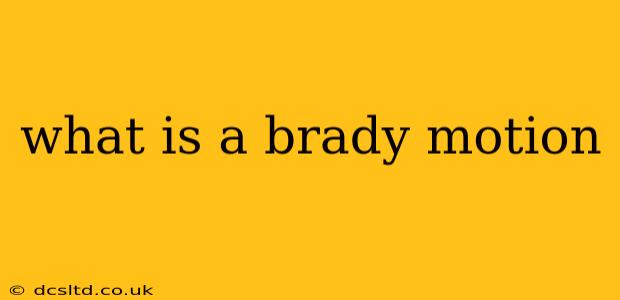A Brady motion, named after the landmark Supreme Court case Brady v. Maryland (1963), is a crucial legal procedure in the United States criminal justice system. It's a request made by the defense attorney to the prosecution to disclose any evidence that could exonerate the defendant or mitigate their sentence. This isn't just about evidence that directly proves innocence; it encompasses a broader range of materials that could cast doubt on the prosecution's case. Understanding its implications is vital for both defendants and the pursuit of justice.
What kind of evidence is covered by Brady?
The Brady rule mandates the disclosure of exculpatory evidence – evidence that tends to clear a defendant of guilt – as well as impeachment evidence. Impeachment evidence is material that could cast doubt on the credibility of a prosecution witness. This could include:
- Statements by witnesses: Prior inconsistent statements, evidence of bias, or information suggesting a witness's perception might be unreliable.
- Police reports: Notes or reports that contradict the prosecution's version of events or highlight inconsistencies in the investigation.
- Forensic evidence: Lab results, DNA analysis, or other scientific evidence that could challenge the prosecution's case.
- Information about informants: Details about the reliability and motivations of confidential informants.
- Evidence of misconduct by law enforcement: Any indication of police wrongdoing, such as planting evidence or coercing confessions, directly affects the fairness of the trial and must be disclosed.
What happens if the prosecution fails to disclose Brady material?
Failure to disclose Brady material can have severe consequences. If the prosecution withholds evidence that is material and prejudicial (meaning it could have affected the outcome of the trial), the conviction can be overturned. This is because the defendant was denied a fair trial. The remedy could involve a new trial, dismissal of charges, or other appropriate relief. The severity of the sanction depends on the nature and significance of the undisclosed evidence.
How does a Brady motion work in practice?
A Brady motion is formally filed by the defense attorney with the court. It typically requests specific information or categories of evidence that the defense believes the prosecution possesses. The prosecution is then obligated to review its files thoroughly and disclose any potentially relevant Brady material. The defense can then use this information to build its case, challenge the prosecution's evidence, or negotiate a plea bargain.
What if the defense believes the prosecution is not fully cooperating?
If the defense attorney suspects the prosecution is not fully complying with its Brady obligations, several steps can be taken. They can request a court order compelling disclosure, argue for sanctions against the prosecution for non-compliance, or even file a motion to dismiss the case. The judge plays a crucial role in overseeing this process and ensuring that the prosecution fulfills its responsibilities.
What are some common examples of Brady violations?
Examples of Brady violations often involve the withholding of:
- Exculpatory DNA evidence: Evidence that points to another person as the perpetrator.
- Witness statements that contradict key prosecution witnesses: Statements that undermine the credibility of a central witness's testimony.
- Evidence of police misconduct: For example, a police officer falsifying a report or using excessive force during an arrest.
The Brady rule is a cornerstone of the American justice system, ensuring fairness and due process for all defendants. Its careful application is essential for maintaining the integrity of the legal process. If you suspect a Brady violation, consulting with a knowledgeable criminal defense attorney is crucial.
